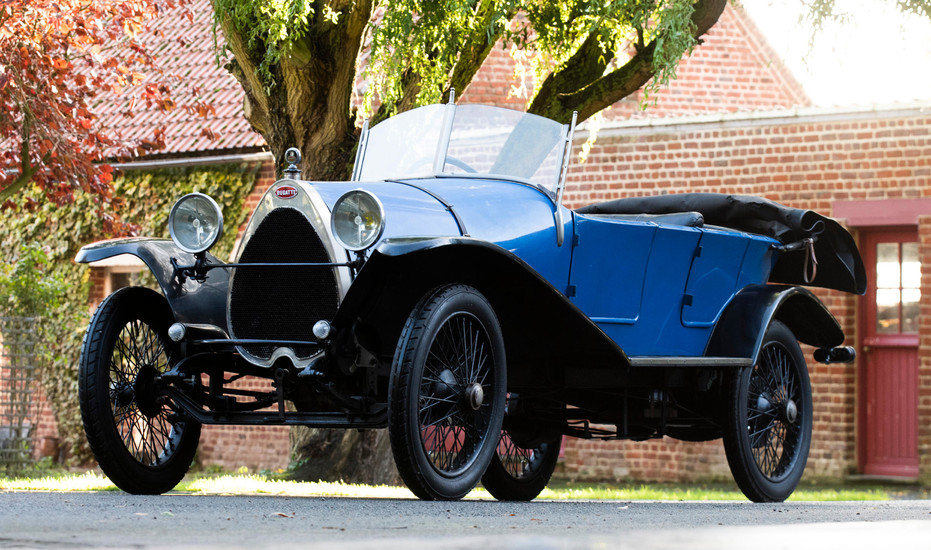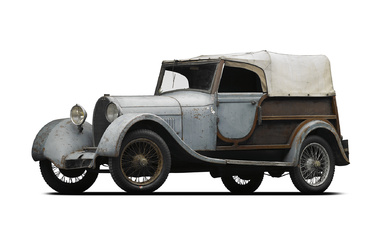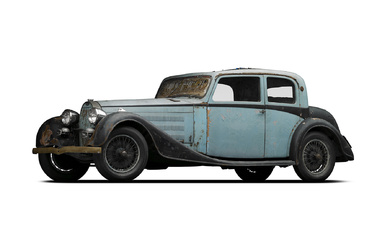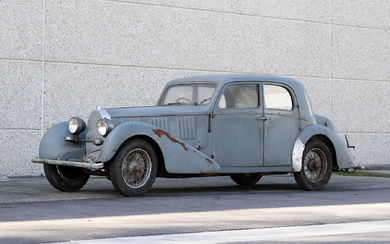1922 Bugatti Type 23 Torpedo Sport
1922 Bugatti Type 23 Torpedo Sport
Chassis no. 1573
Engine no. 39
•1½-litre 16-valve engine
•Original coachwork by Carrosserie Moderne de Schiltigheim (F)
•Part of the Mario Righini Collection for circa 25 years
•Most probably one of the most original examples still in existence
Introduced in 1913 and listed until 1926, the Type 23 was directly descended from first Bugatti to be built at Molsheim: the short-wheelbase Type 13 of 1910. By the early 1930s, Ettore Bugatti - 'Le Patron' - had established an unrivalled reputation for building cars with outstanding performance on road or track, the world's greatest racing drivers enjoying countless successes aboard the Molsheim factory's products and often choosing them for their everyday transport. Bugatti's origins, though, were a far cry from the glamorous world of Grands Prix.
Italian-born engineer Ettore Bugatti had learned his trade with De Dietrich, Mathis and Deutz before setting up his own factory in 1910 at Molsheim in Alsace, which was then part of Germany. While with Deutz he designed the Type 10, its number reflecting his nine previous designs, and this would serve as the prototype for the first Molsheim-built Bugatti: the Type 13. Introduced in 1910 and the first Bugatti production car, the Type 13 was powered by a four-cylinder, single-overhead-camshaft, 8-valve engine of 1,327cc, which drove via a four-speed gearbox and was mounted in a short-wheelbase chassis carrying a simple open two-seater body. Making its debut at the 1910 Paris Salon, the Type 13 was described by The Autocar as a "most delightful looking runabout". The design was developed through Types 15, 17, 22 and 23 into the early 1920s, by which time 435 of all types had been made.
The 'Brescia' version of the Type 13 took that name following the factory's first four places at the 1921 Italian Grand Prix for Voiturettes, held at the eponymous racetrack in Lombardy. The Type 22 and Type 23 were longer wheelbase models, both of which used the 1,496cc single-overhead-camshaft 16-valve Brescia engine and were built alongside 8-valve 'Petit Pur Sang' versions. The arrival of the Type 22/23 in 1912 marked the adoption of Bugatti's famous oval radiator, replacing the flat-topped earlier type.
According to the Italian Bugatti registry of Italian marque authority Francesco Guasti the car was delivered on December14th 1922 but little is known of the history of this Bugatti Type 23 but that is was owned in the '60s by Mario Longoni until in 1994 it joined the celebrated private collection of Mario Righini, where it would remain close on a quarter of a century until purchased by the current vendor. Finished in blue with black wings, the car retains its original three-seater body and is described by the vendor as partially restored, having been repainted circa 1960. The coachwork is said to be in very good original condition and the original black leather interior excellent, benefiting from a re-upholstered front cushion and a re-trimmed hood (done in November 2019). At the same time a new fuel tank was made and fitted to the car, the original one is nevertheless offered with the lot. The chassis is described as in excellent original condition, and the engine and transmission are reported as in good working order. The car is offered with a French Carte Grise. An extremely rare opportunity of acquiring a 'time warp' early Bugatti!
View it on
Estimate
Time, Location
Auction House
1922 Bugatti Type 23 Torpedo Sport
Chassis no. 1573
Engine no. 39
•1½-litre 16-valve engine
•Original coachwork by Carrosserie Moderne de Schiltigheim (F)
•Part of the Mario Righini Collection for circa 25 years
•Most probably one of the most original examples still in existence
Introduced in 1913 and listed until 1926, the Type 23 was directly descended from first Bugatti to be built at Molsheim: the short-wheelbase Type 13 of 1910. By the early 1930s, Ettore Bugatti - 'Le Patron' - had established an unrivalled reputation for building cars with outstanding performance on road or track, the world's greatest racing drivers enjoying countless successes aboard the Molsheim factory's products and often choosing them for their everyday transport. Bugatti's origins, though, were a far cry from the glamorous world of Grands Prix.
Italian-born engineer Ettore Bugatti had learned his trade with De Dietrich, Mathis and Deutz before setting up his own factory in 1910 at Molsheim in Alsace, which was then part of Germany. While with Deutz he designed the Type 10, its number reflecting his nine previous designs, and this would serve as the prototype for the first Molsheim-built Bugatti: the Type 13. Introduced in 1910 and the first Bugatti production car, the Type 13 was powered by a four-cylinder, single-overhead-camshaft, 8-valve engine of 1,327cc, which drove via a four-speed gearbox and was mounted in a short-wheelbase chassis carrying a simple open two-seater body. Making its debut at the 1910 Paris Salon, the Type 13 was described by The Autocar as a "most delightful looking runabout". The design was developed through Types 15, 17, 22 and 23 into the early 1920s, by which time 435 of all types had been made.
The 'Brescia' version of the Type 13 took that name following the factory's first four places at the 1921 Italian Grand Prix for Voiturettes, held at the eponymous racetrack in Lombardy. The Type 22 and Type 23 were longer wheelbase models, both of which used the 1,496cc single-overhead-camshaft 16-valve Brescia engine and were built alongside 8-valve 'Petit Pur Sang' versions. The arrival of the Type 22/23 in 1912 marked the adoption of Bugatti's famous oval radiator, replacing the flat-topped earlier type.
According to the Italian Bugatti registry of Italian marque authority Francesco Guasti the car was delivered on December14th 1922 but little is known of the history of this Bugatti Type 23 but that is was owned in the '60s by Mario Longoni until in 1994 it joined the celebrated private collection of Mario Righini, where it would remain close on a quarter of a century until purchased by the current vendor. Finished in blue with black wings, the car retains its original three-seater body and is described by the vendor as partially restored, having been repainted circa 1960. The coachwork is said to be in very good original condition and the original black leather interior excellent, benefiting from a re-upholstered front cushion and a re-trimmed hood (done in November 2019). At the same time a new fuel tank was made and fitted to the car, the original one is nevertheless offered with the lot. The chassis is described as in excellent original condition, and the engine and transmission are reported as in good working order. The car is offered with a French Carte Grise. An extremely rare opportunity of acquiring a 'time warp' early Bugatti!







